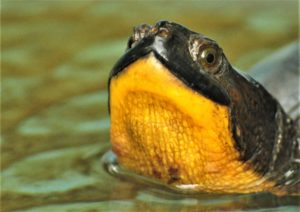Photography courtesy of Lowell Washburn, all rights reserved.
The iconic Blanding’s turtle is facing hard times. By hard times, I mean the species has become so rare that most Iowans – even those who spend considerable time prowling the out-of-doors — will never see so much as a single Blanding’s in their lifetimes.
Although more than a century of wetland drainage has negatively affected all of Iowa’s thirteen turtle species, some of our more familiar varieties – such as painted, soft shelled and snapping turtles – continue to enjoy relative abundance. By contrast, Blanding’s turtles have been far less successful at adapting to ever-changing landscapes. They have become a vanishing link to Iowa’s historic wildlife heritage.
The Blanding’s low reproductive rate contributes to the decline. It takes a female twelve to fifteen years — sometimes longer — to produce her first clutch of eggs. After that, a female may only produce eggs every other year. By comparison, a painted turtle may lay eggs during its fifth summer and may produce a clutch every year after.
When compared to other turtle species, Blanding’s are exceedingly prone to wander, launching lengthy overland journeys in search of nesting sites. Once eggs are laid and buried, all Iowa turtles suffer significant nest losses — mainly due to skunks and raccoons who dig up nests and consume eggs. For Blanding’s turtles, however, nest destruction is catastrophic with losses exceeding eighty and even 90 percent, according to the findings of a wildlife study conducted in southern Minnesota. And although Blanding’s turtles have always endured predator nest loss, the number of modern-day raccoons and striped skunks far exceed the populations found on pre-settlement landscapes.
Historically, Blanding’s turtles were able to offset low recruitment by being exceptionally long lived. In captivity, individuals have been known to live for more than 80 years and, in natural wetland settings, have theoretical productive lifespans of a century or more. Unfortunately, the Blanding’s extreme longevity may give a misleading impression that populations are stable when in reality, just the opposite is true. Wildlife Diversity Biologist, Bruce Ehresman distilled it best by stating, “We’re seeing the same turtles our grandparents watched.”
Sadly, I’m not unique in the fact that every Blanding’s turtle I’ve seen in my lifetime has been an adult, and I’m seeing far less of those than I did in the 1960s, ‘70s and early l980s. One of my most bizarre encounters occurred while bow hunting for spring turkeys on the Don Nissen farm, located along the Winnebago river southwest of Fertile. Arriving well before daybreak, I had set my portable archery blind atop some winter flattened grasses. After settling in, I soon became aware that I was not alone in the pitch dark. Something was stirring beneath the lodged vegetation. My first thought was skunk, or maybe a raccoon. Space was cramped and neither option – being sprayed or being bitten – seemed all that appealing. After listening to a bit more rustling, I cautiously reached out. To my relief, it was neither a skunk or raccoon. What my hand detected instead was the hard shell of a turtle. The smooth helmet-shaped dome told me all I needed to know – I had inadvertently captured a large Blanding’s turtle. I don’t remember whether or not I bagged a gobbler that April morning – probably not. But what I haven’t forgotten is the extreme improbability of capturing a rare Blanding’s turtle by accidentally placing a popup blind directly over the top of what may have been the species’ only representative for miles around.
Facing an uncertain future, the Blanding’s turtle is now listed as a “Threatened Species of greatest conservation need”. Hopefully, wildlife researchers will discover ways to prevent even further declines before the same turtles our grandparents watched disappear completely.



 Tom Cope
Tom Cope Sue Wilkinson
Sue Wilkinson Susan Judkins Josten
Susan Judkins Josten Rudi Roeslein
Rudi Roeslein Elyssa McFarland
Elyssa McFarland Mark Langgin
Mark Langgin Adam Janke
Adam Janke Joe Henry
Joe Henry Kristin Ashenbrenner
Kristin Ashenbrenner Joe Wilkinson
Joe Wilkinson Dr. Tammy Mildenstein
Dr. Tammy Mildenstein Sean McMahon
Sean McMahon